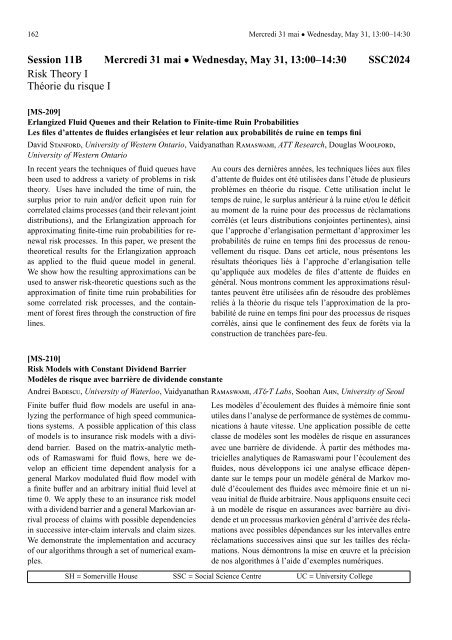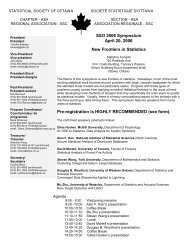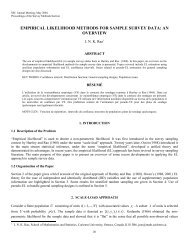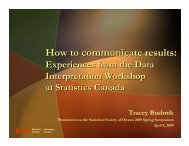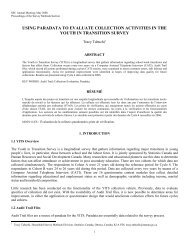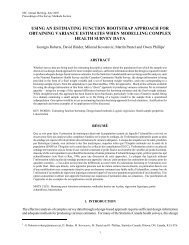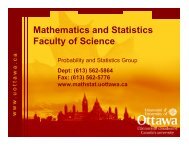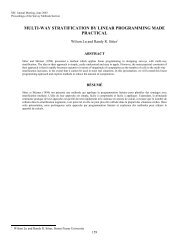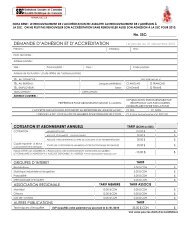Programme et résumés (pdf) - Société statistique du Canada
Programme et résumés (pdf) - Société statistique du Canada
Programme et résumés (pdf) - Société statistique du Canada
You also want an ePaper? Increase the reach of your titles
YUMPU automatically turns print PDFs into web optimized ePapers that Google loves.
162 Mercredi 31 mai • Wednesday, May 31, 13:00–14:30Session 11B Mercredi 31 mai • Wednesday, May 31, 13:00–14:30 SSC2024Risk Theory IThéorie <strong>du</strong> risque I[MS-209]Erlangized Fluid Queues and their Relation to Finite-time Ruin ProbabilitiesLes files d’attentes de fluides erlangisées <strong>et</strong> leur relation aux probabilités de ruine en temps finiDavid STANFORD, University of Western Ontario, Vaidyanathan RAMASWAMI, ATT Research, Douglas WOOLFORD,University of Western OntarioAu cours des dernières années, les techniques liées aux filesd’attente de fluides ont été utilisées dans l’étude de plusieursproblèmes en théorie <strong>du</strong> risque. C<strong>et</strong>te utilisation inclut l<strong>et</strong>emps de ruine, le surplus antérieur à la ruine <strong>et</strong>/ou le déficitau moment de la ruine pour des processus de réclamationscorrélés (<strong>et</strong> leurs distributions conjointes pertinentes), ainsique l’approche d’erlangisation perm<strong>et</strong>tant d’approximer lesprobabilités de ruine en temps fini des processus de renou-vellement <strong>du</strong> risque. Dans c<strong>et</strong> article, nous présentons lesrésultats théoriques liés à l’approche d’erlangisation tellequ’appliquée aux modèles de files d’attente de fluides engénéral. Nous montrons comment les approximations résul-tantes peuvent être utilisées afin de résoudre des problèmesreliés à la théorie <strong>du</strong> risque tels l’approximation de la pro-babilité de ruine en temps fini pour des processus de risquescorrélés, ainsi que le confinement des feux de forêts via laconstruction de tranchées pare-feu.In recent years the techniques of fluid queues havebeen used to address a vari<strong>et</strong>y of problems in risktheory. Uses have included the time of ruin, thesurplus prior to ruin and/or deficit upon ruin forcorrelated claims processes (and their relevant jointdistributions), and the Erlangization approach forapproximating finite-time ruin probabilities for renewalrisk processes. In this paper, we present th<strong>et</strong>heor<strong>et</strong>ical results for the Erlangization approachas applied to the fluid queue model in general.We show how the resulting approximations can beused to answer risk-theor<strong>et</strong>ic questions such as theapproximation of finite time ruin probabilities forsome correlated risk processes, and the containmentof forest fires through the construction of firelines.[MS-210]Risk Models with Constant Dividend BarrierModèles de risque avec barrière de dividende constanteAndrei BADESCU, University of Waterloo, Vaidyanathan RAMASWAMI, AT&T Labs, Soohan AHN, University of SeoulFinite buffer fluid flow models are useful in analyzingthe performance of high speed communicationssystems. A possible application of this classof models is to insurance risk models with a dividendbarrier. Based on the matrix-analytic m<strong>et</strong>hodsof Ramaswami for fluid flows, here we developan efficient time dependent analysis for ageneral Markov mo<strong>du</strong>lated fluid flow model witha finite buffer and an arbitrary initial fluid level attime 0. We apply these to an insurance risk modelwith a dividend barrier and a general Markovian arrivalprocess of claims with possible dependenciesin successive inter-claim intervals and claim sizes.We demonstrate the implementation and accuracyof our algorithms through a s<strong>et</strong> of numerical examples.Les modèles d’écoulement des fluides à mémoire finie sontutiles dans l’analyse de performance de systèmes de commu-nications à haute vitesse. Une application possible de c<strong>et</strong>teclasse de modèles sont les modèles de risque en assurancesavec une barrière de dividende. À partir des méthodes ma-tricielles analytiques de Ramaswami pour l’écoulement desfluides, nous développons ici une analyse efficace dépen-dante sur le temps pour un modèle général de Markov mo-<strong>du</strong>lé d’écoulement des fluides avec mémoire finie <strong>et</strong> un ni-veau initial de fluide arbitraire. Nous appliquons ensuite cecià un modèle de risque en assurances avec barrière au divi-dende <strong>et</strong> un processus markovien général d’arrivée des récla-mations avec possibles dépendances sur les intervalles entreréclamations successives ainsi que sur les tailles des récla-mations. Nous démontrons la mise en œuvre <strong>et</strong> la précisionde nos algorithmes à l’aide d’exemples numériques.SH = Somerville House SSC = Social Science Centre UC = University College


